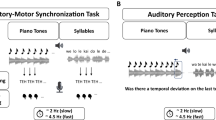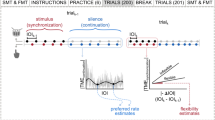Abstract
Two groups of subjects differing in their musical expertise produced periodic finger-tapping sequences involving a pattern of accentuation. In some situations, the taps were synchronized with the clicks of a metronome. We recorded the trajectory of the subjects' finger displacement in the vertical plane, and the force and the moment of occurrence of the taps on the response key. Musicians tended to equalize the durations of the downstrokes at all positions in the sequence. Nonmusicians moved their finger quickly to produce the accent, and more slowly to produce the subsequent tap. These variations in the movement-execution time were partly compensated by opposite variations in the onsets of the movements, e.g., the short-duration movements were delayed. Despite these differences in their movement strategies, musicians and nonmusicians generated very similar tap-timing profiles. The intertap interval after the accent was lengthened regardless of the subjects' musical expertise and the metronome conditions (metronome present or absent). The lengthening did not depend on whether the interval before the accent was shortened (without the metronome) or not (with the metronome). It is suggested that an internal timekeeper may generate temporal goal points at which the keytaps should occur. The lengthening of the interval after the accent is attributed to transient changes in the working of the internal clock.
Similar content being viewed by others
References
Allan, L. G. (1992). The internal clock revisited. In: F. Macar, V. Pouthas, & W. J. Friedman (Eds.), Time, action and cognition: towards bridging the gap (pp. 191–202). Boston: Kluwer Academic Publishers.
Aschersleben, G. (1994). Afferente informationen und die synchronisation von ereignissen. Berlin: Peter Lang.
Bard, C., Paillard, J., Lajoie, Y., Fleury, M., Teasdale, N., Forget, R., & Lamarre, Y. (1992). Role of afferent information in the timing of motor commands: a comparative study with a deafferented patient. Neuropsychologia, 30, 201–206.
Billon, M., Semjen, A., & Stelmach, G. E. (in press). The timing effects of accent production in periodic finger-tapping sequences. Journal of Motor Behavior.
Billon, M., Semjen, A., Cole, J., & Gauthier, G. Sensory information in the production of finger-tapping sequences. Manuscript submitted for publication.
Bootsma, R. J., & van Wieringen, P. C. V. (1990). Timing an attacking forehand drive in table tennis. Journal of Experimental Psychology: Human Perception and Performance, 16, 21–29.
Cooper, W. E., Paccia, J. M., & Lapointe, S. G. (1978). Hierarchical coding in speech timing. Cognitive Psychology, 10, 154–177.
Fraisse, P. (1956). Les structures rythmiques. Louvain: Publications Universitaires de Louvain.
Fraisse, P., & Oléron, G. (1954). La structure intensive des rythmes. L'Année Psychologique, 54, 35–52.
Franek, M., Mates, J., Radil, T., Beck, K., & Pöppel, E. (1991a). Finger tapping in musicians and nonmusicians. International Journal of Psychophysiology, 11, 277–279.
Franek, M., Mates, J., Radil, T., Beck, K., & Pöppel, E. (1991b). Sensorimotor synchronization: Motor responses to regular auditory patterns. Perception & Psychophysics, 49, 509–516.
Ivry, R. I., & Keele, S. W. (1989). Timing functions of the cerebellum. Cognitive Neuroscience, 1, 134–150.
Ivry, R. I., Keele, S. W., & Diener, H. (1988). Differential contributions of the lateral and medial cerebellum to timing and to motor execution. Experimental Brain Research, 73, 167–180.
Jordan, M. I. (1981). The timing of endpoints in movement. Technical report 8104. Center for Human Information Processing, University of California, San Diego.
Kazennikov, O., Wicki, U., Corboz, M., Hyland, B., Palmeri, A., Rowiller, E. M., & Wiesendanger, M. (1994). Temporal structure of a bimanual goal-directed movement sequence in monkeys. European Journal of Neuroscience, 6, 203–210.
Keele, S. W., Ivry, R. I., & Pokorny, A. (1987). Force control and its relation to timing. Journal of Motor Behavior, 19, 96–114.
Keele, S. W., Nicoletti, R., Ivry, R. I., & Pokorny, R. A. (1989). Mechanisms of perceptual timing: Beat-based or interval-based judgements? Psychological Research, 50, 251–256.
Keele, S. W., Pokorny, R. A., Corcos, D. M., & Ivry, R. (1985). Do perception and motor production share common timing mechanisms: A correlational analysis. Acta Psychologica, 60, 173–191.
MacKay, D. (1985). A theory of the representation, organization, and timing of action with implication for sequencing disorders. In E. Roy (Ed.), Neuropsychological studies of apraxia and related disorders (pp. 267–307). Advances in Psychology, 23. New York: Academic Press.
Miall, R. C. (1992). Oscillators, predictions and time. In F. Macar, V. Pouthas, & W. J. Friedman (Eds.), Time, action and cognition: Towards bridging the gap (pp. 215–227). Boston: Kluwer Academic Publishers.
Moore, J. W. (1992). A mechanism for timing conditioned responses. In F. Macar, V. Pouthas, & W. J. Friedman (Eds.), Time, action and cognition: Towards bridging the gap (pp. 229–238). Boston: Kluwer Academic Publishers.
Paillard, J. (1948). Quelques données psychophysiologiques relatives au déclenchement de la commande motrice. L'Année Psychologique, 48, 28–47.
Piek, J. P., Glencross, D. J., Barrett, N. C., & Love, G. L. (1993). The effect of temporal and force changes on the patterning of sequential movements. Psychological Research, 55, 116–123.
Povel, D. J., & Collard, R. (1982). Structural factors in patterned finger tapping. Acta Psychologica, 52, 107–123.
Restle, F. (1970). Theory of serial pattern learning: Structural trees. Psychological Review, 77, 481–495.
Semjen, A., Stress and temporal structure in periodic tapping. Unpublished manuscript.
Semjen, A. (1992). Determinants of timing in serial movements. In F. Macar, V. Pouthas, & W. J. Friedman (Eds.), Time, action and cognition: Towards bridging the gap (pp. 247–261). Boston: Kluwer Academic Publishers.
Semjen, A., & Garcia-Colera, A. (1986). Planning and timing of finger-tapping sequences with a stressed element. Journal of Motor Behavior, 18, 287–322.
Shaffer, L. H. (1982). Rhythm and timing in skill. Psychological Review, 89, 109–122.
Sternberg, S., Knoll, R. L., & Zukofsky, P. (1982). Timing by skilled musicians. In D. Deutsch (Ed.), The Psychology of Music (pp. 181–239). New York: Academic Press.
Summers, J. J., & Burns, B. D. (1990). Timing in human movement sequences. In R. A. Block (Ed.), Cognitive models of psychological time (pp. 181–206). Hillsdale, NJ: Erlbaum.
Treisman, M., Faulkner, A., & Naish, P. L. N. (1992). On the relation between time perception and the timing of motor action: Evidence for a temporal oscillator controlling the timing of movement. Quarterly Journal of Experimental Psychology, 45A, 235–263.
Treisman, M., Faulkner, A., Naish, P. L. N., & Brogan, D. (1990). The internal clock: Evidence for a temporal oscillator underlying time perception with some estimates of its characteritic frequency. Perception, 19, 705–743.
Wing, A. M. (1980). The long and short of timing in response sequences. In G. E. Stelmach & J. Requin (Eds.), Tutorials in motor behavior (pp. 469–486). Amsterdam: North-Holland.
Wing. A. M., & Kristofferson, A. B. (1973). Response delays and the timing of discrete motor responses. Perception & Psychophysics, 14, 5–12.
Author information
Authors and Affiliations
Corresponding author
Rights and permissions
About this article
Cite this article
Billon, M., Semjen, A. The timing effects of accent production in synchronization and continuation tasks performed by musicians and nonmusicians. Psychol. Res 58, 206–217 (1995). https://doi.org/10.1007/BF00419635
Received:
Accepted:
Issue Date:
DOI: https://doi.org/10.1007/BF00419635




